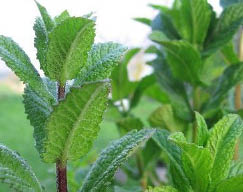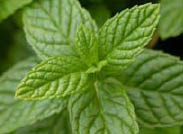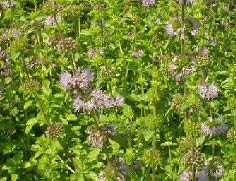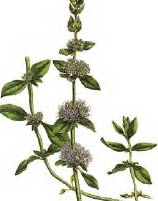|
Search Term: " Penny "
Peppermint oil
Date:
October 30, 2009 12:45 PM
Peppermint leaf is believed to be one of the great herbal remedies and is very useful to have around the house. It is very easy to grow, either in the garden or the home. The herb contains warming oil that is effective as a nerve stimulant. The oil is helpful in increasing oxygen in the blood and working to clean and strengthen the entire body. Peppermint is a great sedative for the stomach. It has been found to contain properties that stimulate the flow of bile and help to settle the stomach after vomiting. The herb is beneficial in dealing with nausea, chills, colic, fevers, gas, and diarrhea. It is able to cleanse, soothe, and relax the body. Peppermint has long been recommended by herbalists for digestive problems. Additionally, it is used for convulsions in infants, to increase respiration, for colds, and to strengthen the entire body.
The menthol that is found in peppermint is believed to be the major component responsible for the medicinal value that it provides. Peppermint plants contain somewhere between fifty and seventy-eight percent menthol. Studies have determined that there are numerous volatile oils in peppermint, which possess antibacterial activity in vitro. It is yet to be determined just how effective peppermint will be in clinical studies. It is also believed that the oil of peppermint is able to sooth gastrointestinal contractions and help to relieve gas. Peppermint’s volatile oils produce relaxation on the smooth muscles. This may be beneficial in conditions such as irritable bowel, abdominal pain, and other gastrointestinal complaints. Research done in 1979 found that peppermint oil capsules were very effective in treating irritable bowel syndrome. A study that was done using laboratory mice found that peppermint leaf extract produces a mild sedative effect. The leaves and oil of the peppermint plant are used to provide antibacterial, anti-inflammatory, anti-spasmodic, aromatic, carminative, diaphoretic, rubefacient, and stimulant properties. The primary nutrients found in this herb are copper, iodine, inositol, iron, magnesium, niacin, potassium, silicon, sulfur, and vitamins A and C. Primarily, peppermint is extremely beneficial in dealing with appetite loss, colds, colic, digestion, fever, gas, headaches, heartburn, nausea, nerves, shock, bowel spasms, and vomiting. Additionally, the herb is very helpful in treating chills, cholera, constipation, convulsions, stomach cramps, uterine cramps, depression, dizziness, flu, heart problems, insomnia, menstrual problems, morning sickness, motion sickness, neuralgia, shingles, mouth sores, stomach spasms, and sore throat. In order to obtain the best results when supplementing with this make sure the peppermint supplement is enteric coated. For more information on the many beneficial effects provided by Pennyroyal, please feel free to consult a representative from your local health food store with questions.
(https://vitanetonline.com:443/forums/Index.cfm?CFApp=1&Message_ID=2109) Pennyroyal Herb
Date:
October 29, 2009 12:56 PM
Pennyroyal was brought by European settlers to the New World. There, they found that Native Americans were using the American variety of Pennyroyal for repelling insects, skin irritations, and many of the same illnesses that they were using their own variety for. Additionally, this herb was used to soothe the stomach and relieve cold symptoms. The Pennyroyal that is found in America has similar properties to the herb that is found in Europe. However, the European variety is thought to be much more potent. This herb possesses a volatile oil that works to remove gas from the stomach. It can be consumed as a tea of used as a footbath. If it is taken a few days before menstruation is due, it can help increase a suppressed flow. The Pennyroyal tea is beneficial in relieving cold symptoms and also promoting perspiration. This herb has a strong, minty odor. It is used externally to repel insects like fleas, flies, and mosquitoes.
The oil of the Pennyroyal plant is extremely concentrated and is often linked to toxic results. The oil is often associated with abortions and convulsions that result in death. It is believed that the oil irritates the uterus, which causes uterine contractions. The action is not predictable and is potentially dangerous. It is recommended that the oil be used only externally as a natural insect repellant. This herb is suggested for use as a decongestant for coughs and colds. Tea that is made from the Pennyroyal herb is not associated with toxicity. In short, the entire Pennyroyal plant is used to provide alterative, antispasmodic, antivenomous, aromatic, carminative, decongestant, diaphoretic, diuretic, emmenagogue, nervine, oxytocic, parasiticide, sedative, stimulant, and stomachic properties. Primarily, Pennyroyal is extremely beneficial in treating bronchitis, childbirth pain, colds, colic, uterine cramps, fevers, gas, lung infections, and absent menstruation. Additionally, this herb is very helpful in dealing with convulsions, coughs, abdominal cramps, delirium, earache, flu, gout, headaches, leprosy, measles, migraines, mucus, nausea, phlegm, pleurisy, pneumonia, smallpox, sunstroke, toothaches, tuberculosis, ulcers, uterine problems, and vertigo. In order to obtain the best results when supplementing with this, or any herb, it is important to consult your health care provider before beginning any regimen. For more information on the many beneficial effects provided by Pennyroyal, please feel free to consult a representative from your local health food store with questions.
(https://vitanetonline.com:443/forums/Index.cfm?CFApp=1&Message_ID=2108) Blue Cohosh
Date:
June 07, 2009 04:16 PM
Blue cohosh is one of the oldest indigenous plants that can be found in America. Blue cohosh is a woodland herb that is slowly becoming endangered because of over harvesting. A small plant that rarely grows more than two and a half feet in height, it can be found blooming in early April on wooded slopes. It was used by Native Americans to treat rheumatism, colic, cramps, epilepsy, and fevers. This herb also aided in childbirth and acted as a contraceptive. Blue cohosh was adopted by early settlers for both delivery and to help reduce fevers. The dried root was considered to be an official herb, found in the United States Pharmacopoeia from 1882 to 1905, where it was recognized for its abilities to induce labor and menstruation. Blue cohosh is also known as Caulophyllum thalictroides, blue ginseng, papoose root, yellow ginseng, blueberry root, and beech drops. This herb has been used to stimulate menstrual flow, induce labor, and for rheumatism, cramps, and epilepsy. The chemical caulosaponin is found in blue cohosh. It is this chemical that induces uterine contractions and should be used only under medical supervision. Additionally, a study that was published in the Journal of Reproduction and Fertility found that blue cohosh is responsible for inhibiting ovulation in animals. Blue cohosh is recommended by herbalists for irregular menstrual cycles, inflammation of the uterus, and to stop false labor pains. This herb has also been used as an antispasmodic and to relieve muscle cramps. Scientific studies have validated these uses, especially the herb’s estrogenic and antispasmodic properties. The hormone and menses-regulating powers have been shown to work best when the herb is combined with Pennyroyal. Some studies have found that blue cohosh may also stimulate the immune system. This herb helps with cases of toxemia and has also been found useful in reducing emotional and nervous tension. In short, the rhizome of blue cohosh is used to provide alterative, anthelmintic, antispasmodid, diuretic, emmenagogue, estrogenic, expectorant, and oxytocic properties. The primary nutrients found in this herb are calcium, chlorine, iron, magnesium, manganese, niacin, phosphorus, potassium, selenium, silicon, sodium, vitamins A, B1, B2, C, and E, and zinc. Primarily, blue cohosh is very beneficial in dealing with pain in childbirth, cramps, epilepsy, and estrogen deficiency, absence of menstruation, urinary problems, and uterine problems. Additionally, this herb has been shown to be extremely helpful in treating high blood pressure, bronchitis, colic, convulsions, cystitis, diabetes, edema, heart palpitations, excessive mucus, neuralgia, spasms, vaginitis, vaginal discharge, and whooping cough. For more information on the many beneficial effects of blue cohosh, please contact a representative from your local health food store. Blue cohosh’s use in cultural and traditional settings is somewhat different from the concepts that are accepted by current Western medicine. It is advisable to consult with a primary health care professional when considering the use of herbal supplements. It may also be advantageous to consult with a practitioner that is trained in the uses of herbal supplements. It is important to note that one should always purchase herbal supplements from a reliable source in order to guarantee safety and efficiency. Blue Cohosh is available in capsule or tablet forms at your local or internet health food store. Look for blue Cohosh in name brands like Natures Answer and Solaray to ensure that you receive a quality product that is pure. *Statements contained herein have not been evaluated by the Food and Drug Administration. Blue Cohosh is not intended to diagnose, treat and cure or prevent disease. Always consult with your professional health care provider before changing any medication or adding Vitamins to medications.
(https://vitanetonline.com:443/forums/Index.cfm?CFApp=1&Message_ID=2013) Natural Vitamin and Herbal Alternatives For Joint Health
Date:
October 18, 2007 03:58 PM
Joint tissue breaks down and arthritis sets in for a number of reasons, and there are several natural alternatives for joint health that can be use to prevent this and to treat affected joints. Thyroid problems can slow down the production of adrenal hormones that are responsible for the production of cortisone and cosrtisol. These are anti-inflammatories, that when unavailable or in low supply can result in joint inflammation. If you suffer joint pain in the mornings that tends to improve as the day goes on, then it is likely that is the cause since adrenal activity can improve as the day progresses. One of the main reasons for joint tissue breakdown is osteoarthritis whereby the cartilage wears down until it fails to provide the necessary protection against impact between the bones in a joint, or against the friction generated when two bones rub together. Injuries to joints can have the same effect, whereby an injury to a hip or knee can appear to clear up and then later the cartilage wears out sooner than expected. This can take several months or many years, depending on the severity and nature of the injury concerned. Continual wear and tear can also cause joint tissue to break down. Athletes and other sportspersons often suffer twenty years or more after retirement from their sport due to the gradual wearing down of cartilage while they were active. Once they stop, this continues to a lesser extent until the cartilage is eventually worn away sufficiently for it to stop protecting the joint. Problems with the auto-immune system can lead to rheumatoid arthritis and inflammation of the joints. This weakens them and can eventually completely destroy the tissue. In such cases the tissues in the joint tend to swell and become extremely painful. Gout can also damage joints, especially in the big toe. This is caused through a built up of needle sharp uric acid crystals. Another cause is a deficiency in sodium and potassium in the diet that are needed to help maintain calcium in solution. When these metals are in deficiency due, for example, to an adrenal problem or some other reason, calcium can deposit right in the joints, causing undue pain. Calcium and vitamin D deficiencies are commonly associated with arthritis sufferers, and protein deficiencies are also believed to be a contributing factor of rheumatoid arthritis, and it is also true that degenerative arthritis can accompany rheumatoid arthritis. This occurs in almost 40% of cases, and diet and nutrition are now being recognized as a major cause of both types. Deficiencies in folic acid or its natural form of folate, vitamin E, zinc and selenium have all been associated with degeneration of joint tissue, so it makes sense that a supplement of these substances can help to avoid these conditions. Standard medical treatment, however, is for the relief of pain and reduction of inflammation through the prescribing of non-steroidal anti-inflammatory drugs (NSAIDs). Typical NSAIDs are aspirin, ibuprofen and naproxen. Although it relieves pain, paracetamol is not an anti-iflammatory. An alternative to blocking the inflammatory reponse is to help to regenerate the damaged joint tissue. However, reducing the inflammatory response to tissue damage does not address the underlying problem, but masks it. Not only that, but there are side effects associated with the use of NSAIDs. Excessive doses can create serious gastrointestinal problems, such as bleeding, ulcer perforation and even death is possible in severe cases. Anti-inflammatories cause gastric problems in up to 20% of cases The newer Cox-2 inhibitors act on the enzyme that causes the inflammation within the joint, and while these can be very effective, they are still masking the underlying problem. Incidentally, the Cox-2 inhibitors should not be used with NSAIDs, and both increase the possibility of a myocardial infarction or heart attack. Also, if you are taking aspirin to reduce the risk of heart problems, you should be careful not to use other NSAIDs since they can interfere with the effects of the aspirin. More effective in the long run is to treat the conditions with substances that deal with the cause of the problem. Vitamin C, for example, improves the lubrication effect of the synovial fluid in the joints, and vitamin E is a strong antioxidant that can help to repair damaged tissue and improve the circulation within the joints. Joints have very low blood circulation levels, which is a problem when trying to direct drugs to the joint tissues. Vitamin C is also good for improving the integrity of connective tissue. Zinc, manganese and copper are also instrumental in developing strong connective tissue and helping to repair the damage done to the joints. Horsetail is a commonly used herbal remedy that can be taken as a tea, tincture or in capsules. It is the richest natural herbal source of silicon, which is used by the body to form connective tissue and collagen. Damaged connective tissue is rapidly repaired by horsetail, and its strength and elasticity significantly improved. It is commonly used in the treatment of arthritis and osteoporosis. Cat’s Claw is used for its beneficial effect on the immune system, and frequently used successfully to treat osteoarthritis and rheumatoid arthritis. However, this treatment is used more to help reduce the inflammatory effects of the condition than to effect a long lasting cure. Gotu Kola, also called Indian Pennywort, is traditionally used for treating arthritis. The fresh leaves are effective in reducing the inflammation and pain, and help to improve the quality of life of arthritis sufferers. In Australia, it is referred to as ‘the arthritis herb’ and two leaves a day are said to be effective. Another popular remedy is MSM (methylsulfonylmethane), although it is claimed to provide pain relief rather than a cure. Amino acids also seem to help, and L-cysteine helps promote collagen and connective tissue. It appears to work best when taken in combination with vitamin E and selenium that are powerful antioxidants. L-arginine has a similar effect in the reconstruction of joint tissue, again helping to repair damaged connective tissues. There are therefore two approaches to treating both rheumatoid and osteoarthritis, one providing pain relief and reducing inflammation, and the other repairing the damage done to the joint tissues. Vitamins, minerals, trace minerals and herbal remedies are used in both, though it is better to use a combination that provides pain relief and also helps to regenerate strong connective tissues in the joints. When using combinations of remedies it is important that possible interactions are understood, and you should always seek the advice of your physician when using non-prescription remedies of any kind.
(https://vitanetonline.com:443/forums/Index.cfm?CFApp=1&Message_ID=1597) | ||||||||||||||||||||||||||||

 Peppermint was used by both the Romans and Greeks in some of their sacred rites. It was highly regarded for its medicinal purposes. The Romans used mint as a stomach aid and also to promote digestion. The Greeks also used this herb for a variety of different ailments. Mint can be found all throughout stories in Greek mythology. The leaf of peppermint was used by Native Americans in a tea form as a carminative, in order to prevent vomiting, nausea, and fevers. The peppermint plant is native to Europe. There are many different varieties of peppermint. The plant is actually believed to be a hybrid between spearmint and water mint.
Peppermint was used by both the Romans and Greeks in some of their sacred rites. It was highly regarded for its medicinal purposes. The Romans used mint as a stomach aid and also to promote digestion. The Greeks also used this herb for a variety of different ailments. Mint can be found all throughout stories in Greek mythology. The leaf of peppermint was used by Native Americans in a tea form as a carminative, in order to prevent vomiting, nausea, and fevers. The peppermint plant is native to Europe. There are many different varieties of peppermint. The plant is actually believed to be a hybrid between spearmint and water mint.  Additionally, animal studies have found that the azulene in peppermint oil contains anti-inflammatory properties.
Additionally, animal studies have found that the azulene in peppermint oil contains anti-inflammatory properties.  The Pennyroyal herb is a member of the mint genus. It is an essential oil that is extracted and used in aromatherapy. Crushed Pennyroyal leaves and foliage give off a very strong spearmint fragrance. Traditionally, Pennyroyal is used as culinary herb, folk medicine, and abortifacient. This herb was commonly used by the Greeks and Romans as a cooking herb. The Greeks often flavored their wine with Pennyroyal. Additionally, a large number of the recipes in the Roman cookbook of Apicius use Pennyroyal along with herbs such as lovage, oregano, and coriander. Although it was still commonly used for cooking in the Middle Ages, it slowly fell out of use as a culinary herb. Today, it is seldom used. However, the essential oil of Pennyroyal is extremely high in pulegone, which is toxic volatile organic compound, and is therefore poisonous to the liver and can stimulate uterine activity.
The Pennyroyal herb is a member of the mint genus. It is an essential oil that is extracted and used in aromatherapy. Crushed Pennyroyal leaves and foliage give off a very strong spearmint fragrance. Traditionally, Pennyroyal is used as culinary herb, folk medicine, and abortifacient. This herb was commonly used by the Greeks and Romans as a cooking herb. The Greeks often flavored their wine with Pennyroyal. Additionally, a large number of the recipes in the Roman cookbook of Apicius use Pennyroyal along with herbs such as lovage, oregano, and coriander. Although it was still commonly used for cooking in the Middle Ages, it slowly fell out of use as a culinary herb. Today, it is seldom used. However, the essential oil of Pennyroyal is extremely high in pulegone, which is toxic volatile organic compound, and is therefore poisonous to the liver and can stimulate uterine activity.  In fact, it helps to relax the digestive tract and soothe the stomach.
In fact, it helps to relax the digestive tract and soothe the stomach. 



